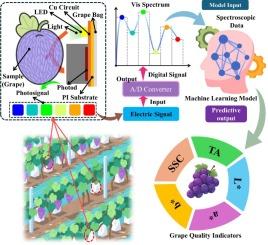袋装水果原位柔性无损无线传感
IF 4.9
2区 化学
Q1 CHEMISTRY, ANALYTICAL
引用次数: 0
摘要
水果袋装技术虽然可以提高水果品质,减少伤害,但对直接监测果实成熟度和品质造成了障碍,迫切需要开发原位无损袋内传感技术。本研究旨在设计和开发一种基于柔性电子技术的原位柔性无线频谱传感系统(IFWS),实现对袋装水果品质的原位、无损、快速监测和准确传感。IFWS通过激光刻蚀Cu/PI薄膜制作柔性电路,集成可见光谱传感器、微控制器等电子元件,使系统具有优异的灵活性,克服了袋装水果质量检测中刚性传感器的空间限制和表面拟合难题。利用IFWS采集的光谱数据,利用MLR模型分析光谱数据与袋装果实品质参数(SSC、TA、颜色参数L*、a*、b*)的相关性。该模型具有较强的预测能力,能够准确预测糖积累(R2cv = 0.865)、酸代谢(R2cv = 0.635)和色素合成(R2cv>0.86)。预测集验证结果表明,SSC预测的RPD值为2.7,颜色参数的RPD值均大于3,证实了IFWS在袋装水果品质预测中的适用性。在袋装水果的生长环境中,IFWS成功地从两个维度(时间演化和种群变异)捕捉到了水果生长过程中品质的动态变化,验证了其在复杂田间场景中的预测效果。通过将MLR模型算法集成到微控制器中,实现了品质预测的实时可视化,进一步实现了对袋装水果品质和成熟度的快速评估。综上所述,IFWS将柔性电子技术与机器学习算法相结合,实现了袋装水果的数字化质量评估,为智慧农业的精准化、数字化发展提供了关键技术支撑,对促进袋装水果的高效管理具有重要的应用价值。本文章由计算机程序翻译,如有差异,请以英文原文为准。

In-situ flexible non-destructive wireless sensing for bagged fruits
Although fruit bagging technology can enhance fruit quality and reduce damage, it poses an obstacle to the direct monitoring of fruit ripeness and quality, creating an urgent need to develop in-situ non-destructive in-bag sensing technologies. This study aims to design and develop an in-situ flexible wireless spectral sensing system (IFWS) based on flexible electronic technology to achieve in-situ, non-destructive, rapid monitoring and accurate sensing of bagged fruit quality. The IFWS fabricates flexible circuit by laser etching Cu/PI film, integrating visible spectral sensor, microcontroller, and other electronic components, which endows the system with excellent flexibility, overcoming the space constraints and surface-fitting challenges faced by rigid sensors in bagged fruit quality inspection. Based on spectral data collected by the IFWS, the MLR model was used to analyze the correlation between the spectral data and bagged fruit quality parameters (SSC, TA, color parameters L*, a*, and b*). The developed model exhibits robust predictive performance, enabling accurate prediction of sugar accumulation (R2cv = 0.865), acid metabolism (R2cv = 0.635), and pigment synthesis (R2cv>0.86). Results from prediction set validation showed that the RPD for SSC prediction was 2.7, with RPD values for color parameters all exceeding 3, confirming the applicability of the IFWS in predicting bagged fruit quality. When deployed in the growing environment of bagged fruits, the IFWS successfully captured dynamic changes in quality during fruit growth from two dimensions (temporal evolution and population variation), validating its predictive efficacy in complex field scenarios. By integrating the MLR model algorithm into the microcontroller, real-time visualization of quality predictions was achieved, further enabling rapid assessment of quality and ripeness of bagged fruits. In summary, the IFWS integrates flexible electronic technology with machine learning algorithms to realize digital quality assessment of bagged fruits, thereby providing critical technical support for the development of precision and digitalization in smart agriculture and holding significant application value for promoting efficient management of bagged fruits.
求助全文
通过发布文献求助,成功后即可免费获取论文全文。
去求助
来源期刊

Microchemical Journal
化学-分析化学
CiteScore
8.70
自引率
8.30%
发文量
1131
审稿时长
1.9 months
期刊介绍:
The Microchemical Journal is a peer reviewed journal devoted to all aspects and phases of analytical chemistry and chemical analysis. The Microchemical Journal publishes articles which are at the forefront of modern analytical chemistry and cover innovations in the techniques to the finest possible limits. This includes fundamental aspects, instrumentation, new developments, innovative and novel methods and applications including environmental and clinical field.
Traditional classical analytical methods such as spectrophotometry and titrimetry as well as established instrumentation methods such as flame and graphite furnace atomic absorption spectrometry, gas chromatography, and modified glassy or carbon electrode electrochemical methods will be considered, provided they show significant improvements and novelty compared to the established methods.
 求助内容:
求助内容: 应助结果提醒方式:
应助结果提醒方式:


